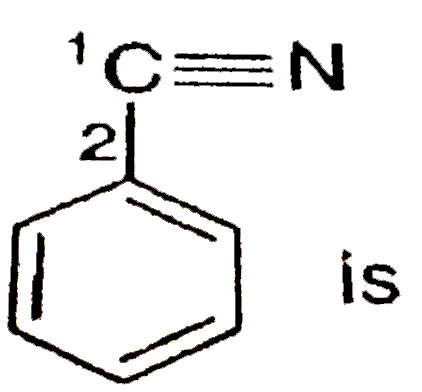II. Read the following passage and answer questions 6-10 that follow :
During organic reactions, a covalent bond between two carbon atoms or carbon atom and some other atom is broken and a new bond is formed. The fission of bonds can be homolytic or heterolytic forming free radicals, carbocations carbanions, carbenes, etc. This also depends upon the displacement, of electron in a bond and is governed by inductive effect, electromeric effect, reasonance and hyperconjugation.
Complete the reaction :
CH2N2Light−−→
and name the species formed.
To complete the reaction of CH₂N₂ (diazomethane) when exposed to light, we need to follow these steps:
1. Identify the Reactant: The reactant given is CH₂N₂, which is known as diazomethane. It has two nitrogen atoms connected to a carbon atom.
2. Understand the Reaction Conditions: The reaction is initiated by light (denoted as "hν"). This indicates that the reaction involves photolysis, where the energy from light breaks chemical bonds.
3. Bond Fission: Under the influence of light, the N-N bond in diazomethane can undergo homolytic fission. This means that the bond breaks evenly, resulting in the formation of two radicals.
4. Formation of Radicals: When the N-N bond breaks, it produces a nitrogen molecule (N₂) and a methylene radical (·CH₂). The reaction can be summarized as follows:
CH2N2hν−→N2+⋅CH2
5. Name the Species Formed: The species formed from this reaction is the methylene radical, which is denoted as ·CH₂.
Final Answer:
The reaction of CH₂N₂ under light produces nitrogen gas (N₂) and the methylene radical (·CH₂).
---
CH2N2hν−→N2+⋅CH2
The reaction of CH₂N₂ under light produces nitrogen gas (N₂) and the methylene radical (·CH₂).
Topper's Solved these Questions
- BOOK - MODERN PUBLICATIONCHAPTER - ORGANIC CHEMISTRY: BASIC PRINCIPLES AND TECHNIQUESEXERCISE - Revision ( Objective Questions ) True or Fales Questions10videos
ORGANIC CHEMISTRY: BASIC PRINCIPLES AND TECHNIQUES
- BOOK - MODERN PUBLICATIONCHAPTER - ORGANIC CHEMISTRY: BASIC PRINCIPLES AND TECHNIQUESEXERCISE - Revision ( Objective Questions ) Fill in the Blanks Questions10videos
ORGANIC CHEMISTRY: BASIC PRINCIPLES AND TECHNIQUES
- BOOK - MODERN PUBLICATIONCHAPTER - ORGANIC CHEMISTRY: BASIC PRINCIPLES AND TECHNIQUESEXERCISE - NCERT EXEMPLAR PROBLEMS ( Long Answer Questions )7videos
ORGANIC CHEMISTRY: BASIC PRINCIPLES AND TECHNIQUES
- BOOK - MODERN PUBLICATIONCHAPTER - MOCK TEST-2EXERCISE - SECTION D1videos
MOCK TEST-2
- BOOK - MODERN PUBLICATIONCHAPTER - REDOX REACTIONS EXERCISE - COMPETITION FILE (Objective Questions) (C. MULTIPLE CHOICE QUESTIONS)9videos
REDOX REACTIONS
Similar Questions
II. Read the following passage and answer questions 6-10 that follow :
During organic reactions, a covalent bond between two carbon atoms or carbon atom and some other atom is broken and a new bond is formed. The fission of bonds can be homolytic or heterolytic forming free radicals, carbocations carbanions, carbenes, etc. This also depends upon the displacement, of electron in a bond and is governed by inductive effect, electromeric effect, reasonance and hyperconjugation.
Which of the two Ph3C+ or (CH2)3C+ is more stable and why?View SolutionII. Read the following passage and answer questions 6-10 that follow :
During organic reactions, a covalent bond between two carbon atoms or carbon atom and some other atom is broken and a new bond is formed. The fission of bonds can be homolytic or heterolytic forming free radicals, carbocations carbanions, carbenes, etc. This also depends upon the displacement, of electron in a bond and is governed by inductive effect, electromeric effect, reasonance and hyperconjugation.
Which of the two CH2=CH− or HC≡C− is a better nucleophile?View Solution
Knowledge Check
- Question 1 - Select One
Ethylene has ………. Bond between two carbon atoms.
Aa singleBa doubleCa tripleDan ionic - Question 2 - Select One
The bond between carbon atom (1) and carbon atom (2) in compound
 Asp3 and sp2 hybridisedBsp2 and sp3 hybridisedCsp and sp2 hybridisedDsp and sp hybridised
Asp3 and sp2 hybridisedBsp2 and sp3 hybridisedCsp and sp2 hybridisedDsp and sp hybridised - Question 3 - Select One
Carbon forms bonds with other atoms
Aby gaining electronsBby losing electrons.Cby sharing electronsDnone of the above
II. Read the following passage and answer questions 6-10 that follow :
During organic reactions, a covalent bond between two carbon atoms or carbon atom and some other atom is broken and a new bond is formed. The fission of bonds can be homolytic or heterolytic forming free radicals, carbocations carbanions, carbenes, etc. This also depends upon the displacement, of electron in a bond and is governed by inductive effect, electromeric effect, reasonance and hyperconjugation.
Do (CH3)3C+ and (CH3)3C− have same structure? Explain.View SolutionII. Read the following passage and answer questions 6-10 that follow :
During organic reactions, a covalent bond between two carbon atoms or carbon atom and some other atom is broken and a new bond is formed. The fission of bonds can be homolytic or heterolytic forming free radicals, carbocations carbanions, carbenes, etc. This also depends upon the displacement, of electron in a bond and is governed by inductive effect, electromeric effect, reasonance and hyperconjugation.
Which of the following is most stable and why?
CH−3,−CH2CI,−CHCI2,−CI3View SolutionA double bond between two carbon atoms is formed by
View SolutionFor a covalent bond to form between two atoms A and B.
View SolutionCovalent bond is formed between the atoms of
View Solution

